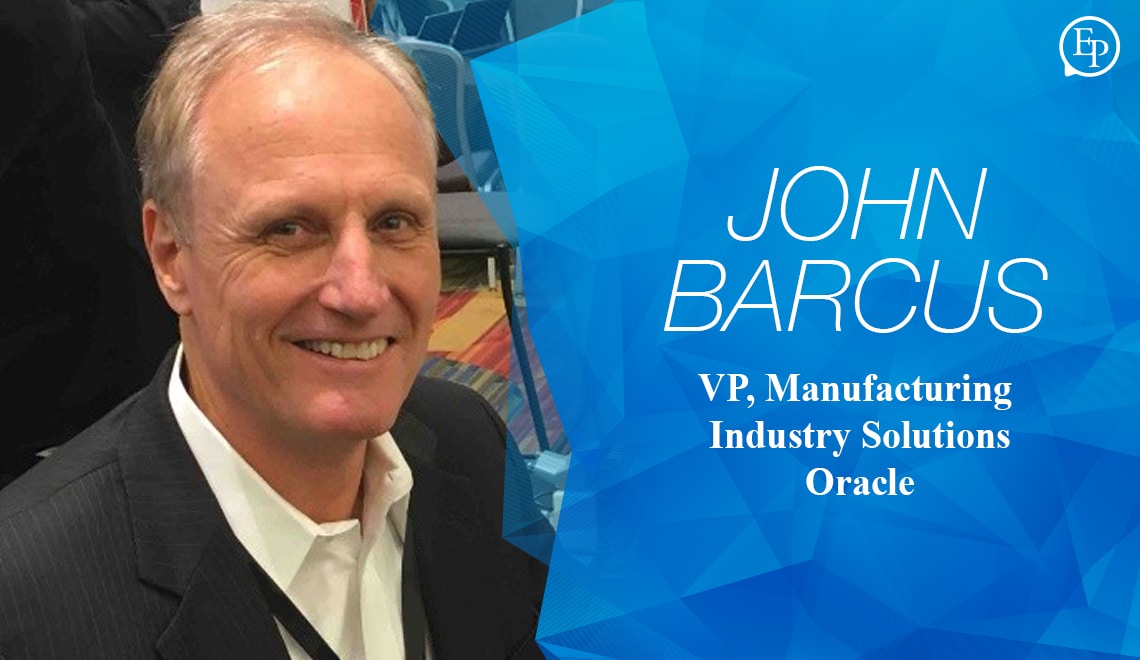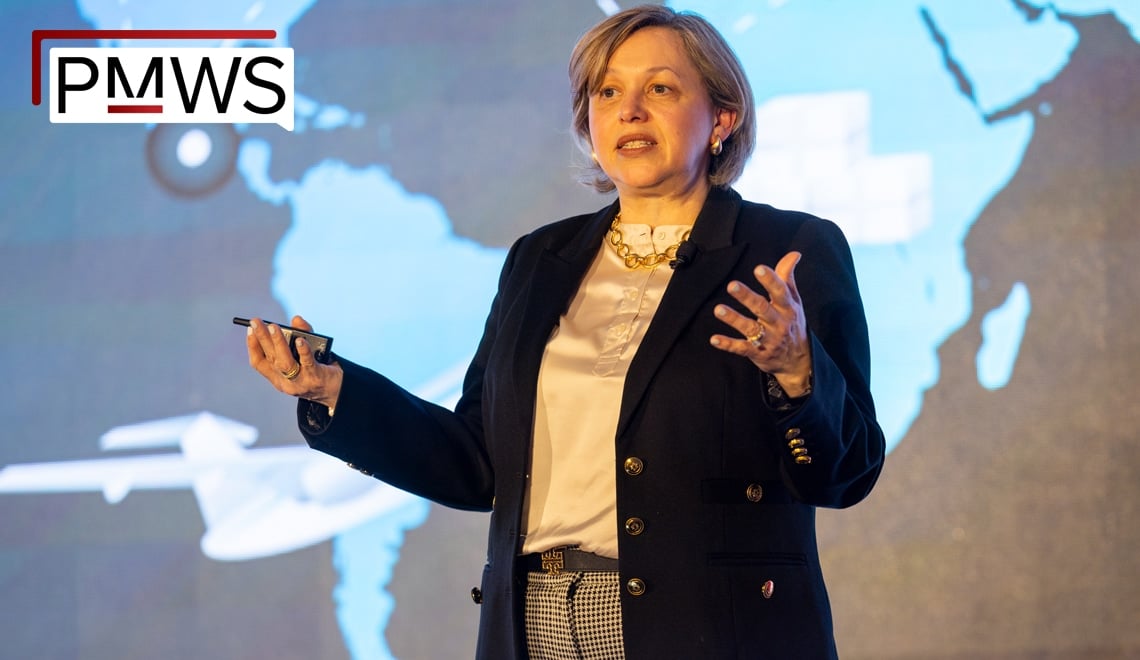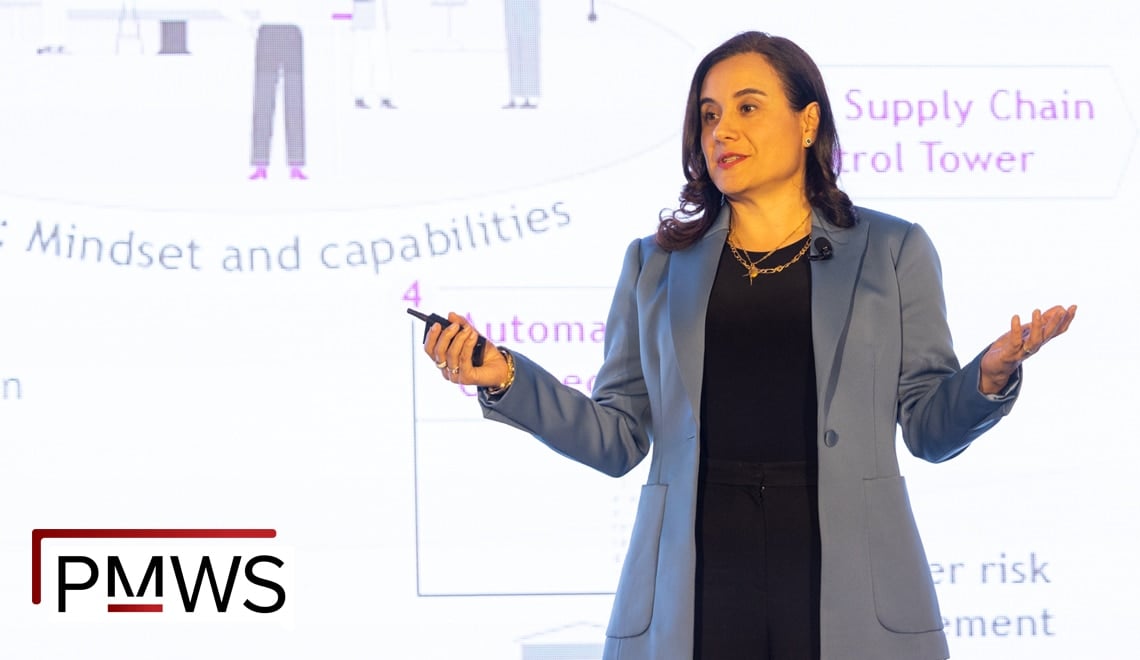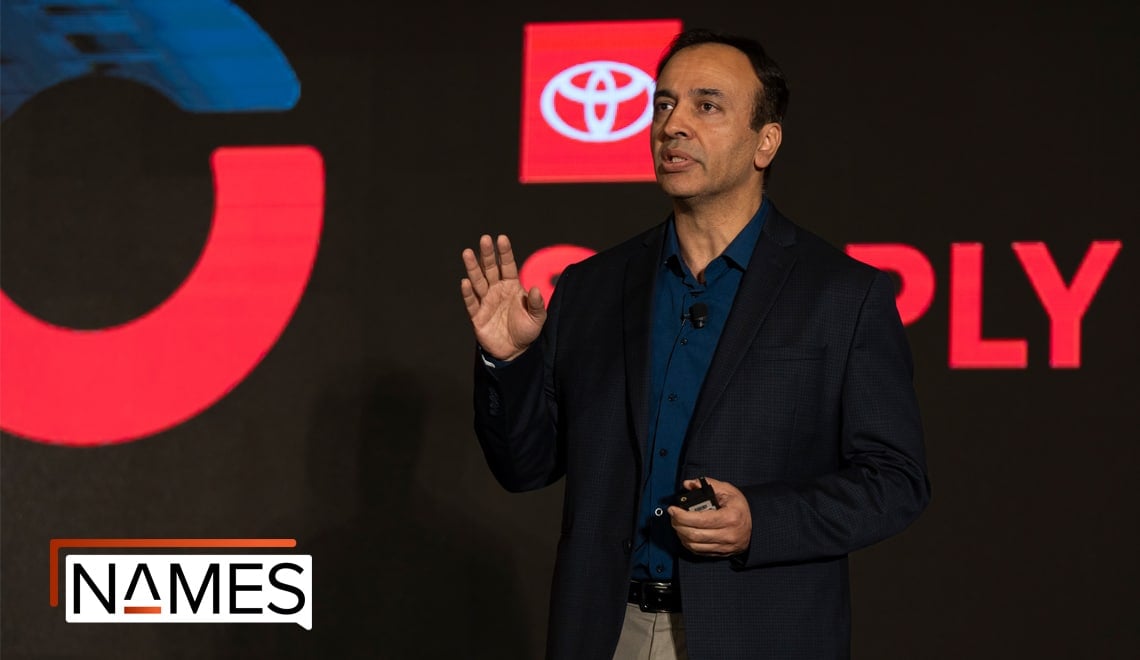As part of the 2018 edition of the North American Supply Chain Executive Summit, John Barcus, Oracle’s VP, Manufacturing Industry Solutions, gave an in-depth interview on how Industry 4.0 solutions are changing the very nature of Integrated Business Planning.
The full transcript of the interview is below, or you can download a PDF version.
I read recently that Supply Chain Management is on its way to becoming technology-centric as opposed to simply technology-enabled. Can you tell us a little about that?
I think a lot of the technologies that are coming out today are really changing the dynamics of the way supply chains work. Historically people would have a supply chain with particular processes in place that they would need to support, and they would leverage technology to enable those processes. What is different today is that the technology itself is changing those processes, and changing them significantly.
As an example, service models are significantly different than they ever were before. People are selling services, they’re selling products, they’re selling products as a service. I think dynamically it will happen more and more as the technologies continue to evolve and the pace of evolution is such that the technology will continue to drive changes in the way that supply chains act.
What is driving companies to embrace these new tools?
I think competitive requirements are doing that: One, people don’t want to be left behind; two, customer expectations are increasing significantly, and companies are seeking ways to fulfill those expectations, and then, three, I think there is a desire to become a little more ‘sticky’ with their customers and provide better services. Actually offering solutions to the specifics of what a customer wants rather than just offering a product that the customer may be accepting without necessarily fulfilling their ultimate requirements.
Let’s get into a few specifics. When we talk about a Digital Supply Chain with Integrated Business Planning, what are we actually changing in the way supply chain executives plan and run their operations?
One, I think we’re changing the overall way companies can plan their supply chains in regards to prepare for and then automatically execute against that supply chain. As an example, one of the big challenges companies have today is when you have a terrible plan in the beginning, then what ends up happening is everything after that goes sour.
When you have a poor foundation for your house, the house potentially can fall apart. It’s the exact same impact with supply chain planning. The better your forecast and the better that forecast is aligned to your business objectives and your capabilities, the more likely you are to be successful. There’s nothing worse than when you develop a plan and execute on that plan and then discover halfway through that you are not able to perform with that plan.
Integrated Business Planning brings together all the pieces of an organization to put together a plan that is actually achievable and that meets the objectives of the business itself. It goes through a multistep process that includes a product review and an understanding of what is being released, what is being changed, are you able to deliver on those changes? It includes a demand review. What are the unconstrained demands of the market as it relates to the products you have today and the planned release of products in the future? Then there is also a supply review to validate you can actually perform against your plan and achieve the requirements of the demand that exists out there. You also want to go through a financial review to make sure everything adheres to the constraints you might have to ensure you can execute successfully. Finally, you want a management review where everyone validates the information that has come forth to allow for execution of that plan.
Some organizations might want to do something like this enterprise-wide, and others might prefer to do small test cases and scale things up gradually over time. Can you walk us through some of the pros and cons of the two approaches?
The ultimate goal is for a company to do this enterprise-wide. The more holistic you are able to do this, the more likely you are to find success, because you will have more information available to validate you have a correct plan.
With that said, you can’t start off that way necessarily, right? That create a lot of different avenues to try and execute all at once. One way potentially to do this is to start off with a small group of products or a product line to execute on, as long as there is minimal overlap with other businesses you might have. Another way, and this is what the majority of the companies that we work with are doing, is to identify their particular pain point and focus on addressing that pain point first. That doesn’t necessarily mean you forgo the opportunity to do Integrated Business Planning and bring in other groups and go through all the processes, but you have a specific focus on one aspect of your business.
For example, let’s say forecasting is a big problem area for you. It makes good sense to start by focusing your efforts on improving that forecast. One of the interesting things about this whole Integrated Business Planning is how it relates to Sales and Operations Planning. For companies we work with, the biggest benefit many of them see is when Integrated Business Planning forces them to put some discipline to the way they develop and execute their plan. The more capability and organization and discipline you put into that process, the more likely you are to find success.
Coming back around to what you were asking specifically, the challenge of course in doing this enterprise-wide is there is a lot more engagement, a lot more people who need to be involved, a lot more processes that will need to be changed. That does lend some credence to doing this on a smaller scope by function or business unit first and then scaling up.
Whenever I’m talking about technological change, I also want to talk about the ‘People Part’ of this conversation. How do people within an existing supply chain organization respond to these new tools, and how does it change the way they work?
Great question. In many companies the biggest challenge is persuading people to accept a new culture with more collaboration, more accountability. Inspiring that need and desire where people have to work together can be challenging, especially when it might appear as if people are questioning their numbers, their information. With that said, most of the time we find people do want to do the right thing. Everyone wants to do a better job. People understand the important of identifying deficiencies: Being late on an order; needing to expedite a part; forecasting incorrectly. Everyone understands that and wants to fix that.
With that said, I think one of the opportunities then is to leverage the technology as a catalyst to support them as they do the work they want to do correctly already. The initiation of a project that is built around technology enables improved activities. The key, though, is not to think about the technology as a replacement for people. That’s one of the big mistakes people made in technology implementation for a long time. There was a perception among the workforce that, ‘Oh, they’re trying to make the company more efficient, which means cutting headcount.’ That’s not the overall objective. I mean, sometimes that is possible, but the real objective is to allow the same people to do more, to do a better job by leveraging the technology to improve performance.
It seems like Integrated Business Planning is something people have been working on for a long time. How is this different? What have you learned along the way that makes you look at the Digital Supply Chain and say, ‘This changes things’?
Great question. Companies have been doing this for some time, as you say. I think with one of the big challenges of the past when it comes to Integrated Business Planning was that technology failed to enable the processes as much as they had hoped.
We’ve learned a lot. We used to build out Integrated Business Planning in a lot of our different tools and then we would tie those tools together to develop a process that would support one plan. As we’ve built these parts from the ground up, we’ve now built them into a single tool that feeds from and feeds to all of the tools that manage a completely integrated business planning process. That allows a single application to manage all of the different processes. It allows collaboration between all the relevant grows. It allows everyone to work with the same numbers and see the same data and execute to the same plan.
Let’s talk about how much impact the Digital Supply Chain is really having. Among your early adaptors and your success stories, what can they do now that they couldn’t do before? What are they hoping to be able to do five years form now that they’re working on today?
I think one of the big challenges companies really have is transitioning from their legacy systems into these new business models. A lot of things come down to priorities. Are you supporting services more than products? Supporting products more than services? Maybe you need to offer services in conjunction with the products? Maybe you are not even selling the products. Maybe you want to automate processes based upon execution signals from the field. Those are the kinds of things we’re seeing not only in our clients’ businesses but in our own business as we transform into a Cloud organization. One of the things we are focusing on is service levels, which weren’t as much of an issue before because they were a little bit distanced from the sales cycle. Today we’re tightly integrated. If you’re not happy with the products you’re using and the user experience, you will not purchase more software or even keep the software you have. That’s a challenge and an opportunity for us, and one of the reasons why we are transforming our business is the benefits of that improved execution piece.
The other area we are seeing, especially on the service side, is this automated digital connection between devices in the field and that trigger automatic stock replenishment. Companies are running their businesses 24/7 because of an IoT feed that lets them monitor equipment and get signals and alerts to identify challenges and activities that are ongoing while they’re not even in the factory at all.
One of the big benefits I think coming along in the next five years is that the focus is going to continue to change. Customers are going to continue to be more demanding. We see a lot of activity right now where the expectation levels are for a very high level of visibility and transparency as it relates to your orders and your association with both customers and suppliers. There is an enormous demand for logistical solutions to provide that kind of transparency, and we believe that demand will continue. I think the connectivity of the whole supply chain will continue to improve and become critical to the success of organizations.
For example, a lot of companies are moving towards Artificial Intelligence to drive decisions. The challenge is, as you get more and more data, it becomes not even feasible for individuals to be able to go through it all and execute it manually as they might have done in the past. There is a huge trend towards companies allowing the tools to do more of the calculations and automate what used to be done manually. To make that happen they have to be much more familiar with the algorithms and the rules and processes in place to get the behaviours they want out of their supply chains.
We’ve talked quite a bit about things within the organization. Where does the end consumer’s expectations fit into the movement towards Digital Supply Chain? How are they driving the business to change?
The first element is the desire to have increased personalization. They want to get exactly what they want. That creates significantly more challenges for the supply chain because the permutations that are possible are significantly greater. A digital supply chain is really the only way to enable that customization in a way that will meet your customer’s expectations.
The second element is speed. Everything you are doing –especially innovation—continues to improve and increase as businesses continue to progress. What is different now is past activities were enabled by hardware or physical fixes. A lot of those now are being enabled by software. You can now have an application out in the field, something working in a particular way, and you can change that behaviour digitally versus having to go out and physically modify it. Speed is in everything we’re doing. The responsiveness to the end customer, and the innovations to update changing requirements, and the ability to innovate new products that meet the needs of the marketplace. All of that is about speed.
Now understanding the marketplace has become easier than in the past because many customers have social feeds of their end-customers.
Automotive manufacturers, for example? Now they don’t sell directly to the customer; they sell through dealers. Still they are monitoring the customers reactions, identifying particular complaints or issues customers have early, and are able to solve them in a much shorter period of time. The cost of not doing that? Well, if I fix it in the factory it costs a dollar. If I fix it before I ship it, it’s ten dollars. If I fix it out in the field, it’s a hundred dollars, right? The shorter the timeframe there is involved in finding those issues, the greater my chances of finding success.
All of this then creates stickiness between the end customer and the manufacturer.
Walking through all of these issues, obviously there is a lot to talk about. What makes Oracle a leader in this space?
Oracle has some huge adventures, one of which is our breadth. I think as we transition to this new world where companies need to react much faster and they need to be able to support new business models that were not supported previously, and they need to support business models that don’t exist today but that they will need to adapt to in the future, in the old days this just wasn’t possible. If you implemented a legacy application, after you receive it you start to customize it, and as soon as you have done that, you are locked in.
Now even if we as Oracle decided to build out new capabilities for you to support new requirements, your ability to accept that is incredibly difficult because you need to accommodate everything you’ve modified and changed to leverage the new capability. Then there’s a long cycle to adapt it.
One of the things Oracle has done is become a leader in Cloud software. We have the most breadth of anyone as it relates to supply chains. That gives us the ability to enable changes to happen at a much faster rate than ever could have happened in the past. You as the customer can come to us and say, “I need new capabilities and new functions.” In the past where I could add them, there would still be a disconnect where you might not be able to accept them. We never have to worry about that anymore.
Second, Oracle recognizes not everything you do comes from us. We are not building everything for you, so we also work with you to allow you to build whatever you need to extend your capabilities and do what you need to do for your customers, knowing that what you add on or bring in from elsewhere will still integrate into our systems too.
Third, I really like the direction we are heading. Oracle is taking a lot of these emerging technologies —Artificial Intelligence, IoT, IIoT, Blockchain—and we are embedding them into our applications across the board. We hear a lot about ‘Digital Natives,’ about how the next generation of users view emerging technologies. We want those tools embedded into our applications so the base of information and data is already there, native to the applications and relevant to whatever our customers are going to want. I mean, just looking at the data on an IoT application is a good first step. The second step is to be able to analyze the data. The third step is to be able to use it, to make a plan with it.
All of this ties back into the benefits I articulated earlier, and we build all of our tools with these emerging technologies already ready to go.
When you discuss these tools and improved capabilities with supply chain executives, what is the key takeaway you want them to think about further?
I think, one, their business model is going to change. Their business is going to continue to evolve, and they need to be prepared for these changes. Two, they need to elect technologies that will help support that transition, not just for what they want to achieve today, but for what they want to achieve tomorrow.
—

VP, Manufacturing Industry Solutions
Oracle
John Barcus is Vice President responsible for the Oracle Global Manufacturing Industries. The Manufacturing Industries Solutions Group works globally with customers, partners, and within Oracle to refine industry strategy and build industry solutions that support the Industrial Manufacturing, Automotive, and High Tech industries.
John has been with Oracle for over 20 years, 8 of which were in consulting working with customers to manage large global ERP and advanced planning projects. John brings to companies a strong manufacturing, supply chain, and industry background. His implementation and business experiences help customers to use technology to solve business issues, gain competitive advantage, and to adapt to the rapidly evolving needs of the digital age.

















